ISSUED: 12 September 2023
MEDIA CONTACT: Cecelia Mason
SHEPHERDSTOWN, WV — An hour before sunrise on Tuesday, July 11, eight Shepherd University students met me and Dr. Zach Musselman in the parking lot behind Byrd Science Center to catch our shuttle to BWI airport. Several hours later, we were half a continent away in Salt Lake City, Utah. After retrieving our baggage and rental vehicles, making a quick stop for tacos, and a not-so-quick stop for supplies, we were cruising north on interstate 15. To our right were snowy peaks of the Wasatch Range even though the ground temperature was in the 90s. To our left, suburbs of the city gave way to farms and occasional glimpses of the easterly-jutting fingers of the Great Salt Lake. Ahead of us was Idaho and our ultimate destination, Yellowstone National Park.
We had begun the 10-day field component of a course I teach on the greater Yellowstone area, including nearby Grand Teton National Park. Although Zach had been to Yellowstone numerous times before, including with students, this was his first time co-teaching a Yellowstone field experience as a Shepherd professor. Zach is a geologist, so I was thrilled to have his contributions. The course takes an integrative approach to studying our nation’s first national park. Over the preceding seven weeks, the students had delved into diverse topics, such as the geology and hydrology of Yellowstone’s hydrothermal features, the ecological impact of wolf reintroduction on the Greater Yellowstone ecosystem, and the conflicts between westward migrating settlers and native peoples that lived in and around the Yellowstone Plateau. Integrating content from traditionally separate subjects like geology, biology, and history is uncommon in higher education. However, in my view, it is the only way to gain a comprehensive understanding of most real-world phenomena, and it is certainly the ideal way to prepare students for a visit to Yellowstone. For example, understanding the dynamics of wolf reintroduction and humanity’s historical relationships with Yellowstone requires consideration of Yellowstone’s unique physical geography.
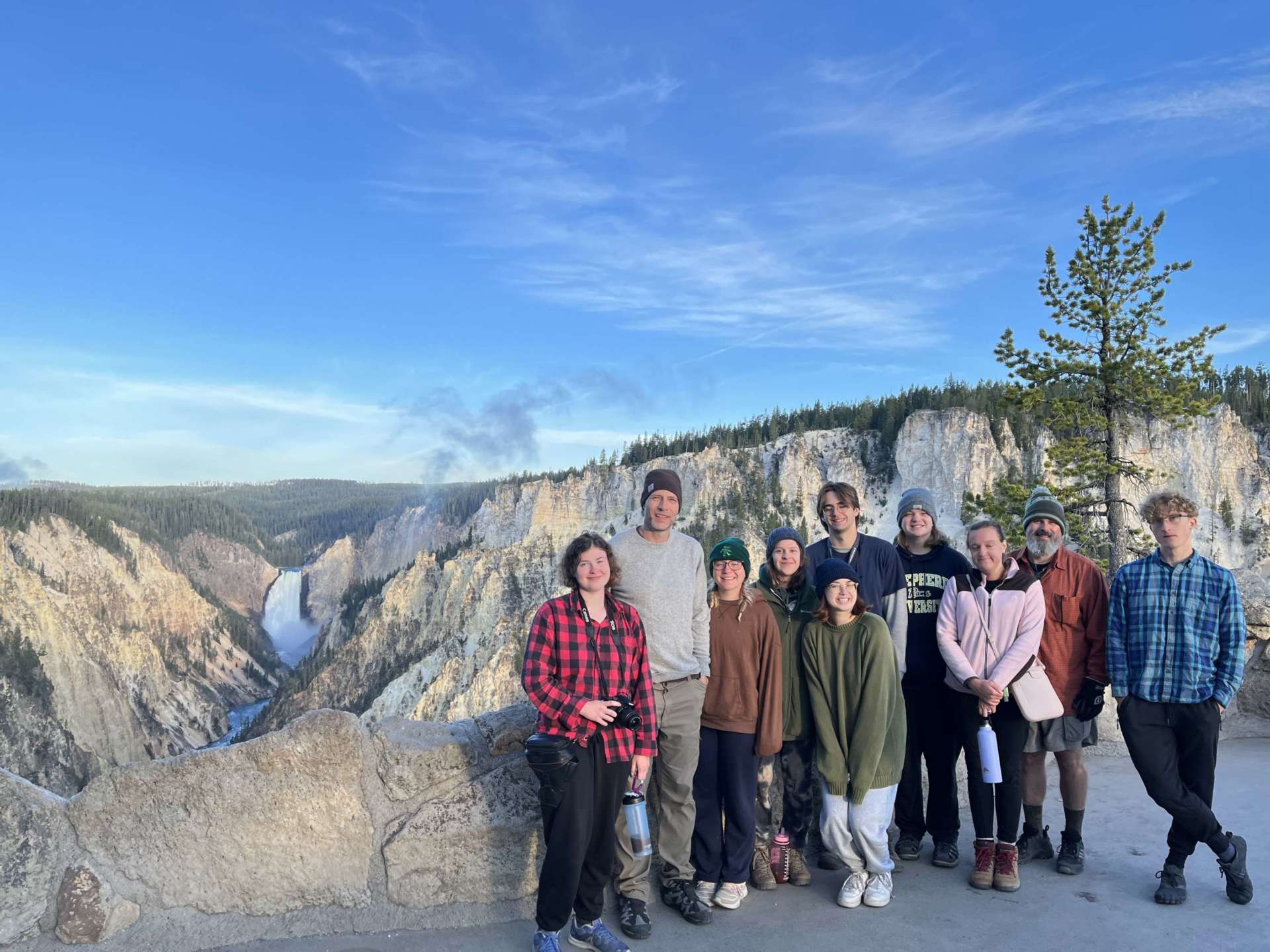
During the field experience, students were immersed in the topics they had been studying in the class. While each day was filled with more than can be summarized here, what follows are some highlights. Our destination on the first day was a group campsite in Caribou-Targhee National Forest in southern Idaho. After setting up camp, most of the group converged in the creek downhill from the campsite. With cool water around our feet, warm sun on our backs, and the rustling of cottonwood trees in the air, we resolved to immerse ourselves in as many creeks, rivers, and lakes as possible during the trip. Some open-range cows on the hillside seemed to be lowing in approval of that idea.
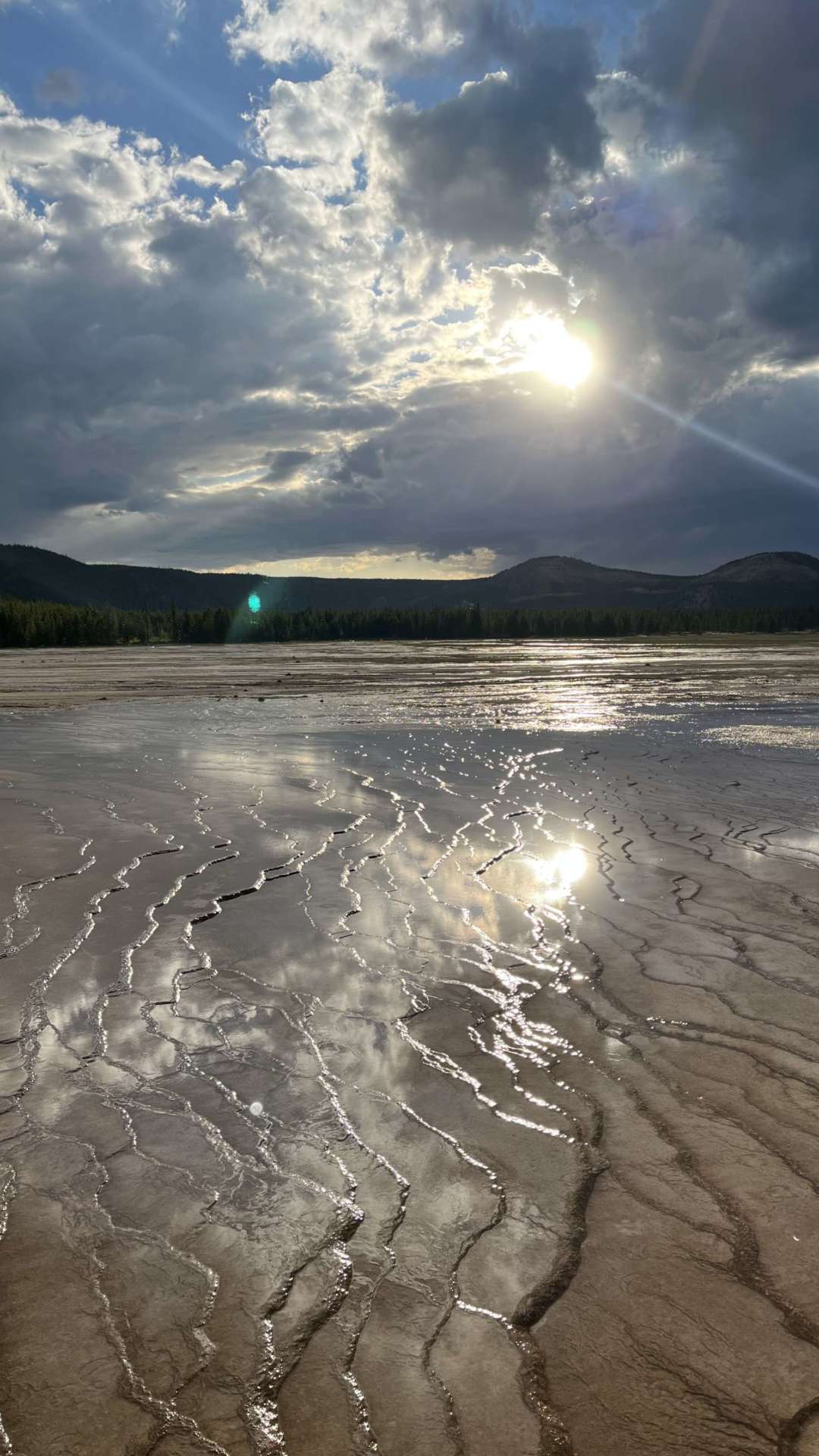 The following day, we continued to Yellowstone, but visited Quake Lake before entering the park. The lake was created by a 1959 earthquake and massive landslide that dammed the Madison River. After entering the park and setting up camp at Madison Junction, we drove to Gibbon Falls, a waterfall at the rim of the caldera formed during the last eruption of the Yellowstone supervolcano 640,000 years ago. In the late afternoon, we explored the boardwalks at Norris Geyser Basin, known for having the hottest hydrothermal features in the park. At Norris, we discovered two things: first, that mosquitoes would be a nuisance during our trip due to heavy winter snowfall and lingering standing water; second, that the long shadows and warm light of a setting sun beautifully complement Yellowstone’s hydrothermal features.
The following day, we continued to Yellowstone, but visited Quake Lake before entering the park. The lake was created by a 1959 earthquake and massive landslide that dammed the Madison River. After entering the park and setting up camp at Madison Junction, we drove to Gibbon Falls, a waterfall at the rim of the caldera formed during the last eruption of the Yellowstone supervolcano 640,000 years ago. In the late afternoon, we explored the boardwalks at Norris Geyser Basin, known for having the hottest hydrothermal features in the park. At Norris, we discovered two things: first, that mosquitoes would be a nuisance during our trip due to heavy winter snowfall and lingering standing water; second, that the long shadows and warm light of a setting sun beautifully complement Yellowstone’s hydrothermal features.
Most of our third day was spent at the Upper Geyser Basin, home to some of the most famous hydrothermal features in the park including Old Faithful and Morning Glory Pool. Yellowstone has over 10,000 hydrothermal features, more than the rest of the world combined, and the Upper Geyser Basin is the most concentrated collection of geysers in the world. Thermophilic microbial life gives springs like Morning Glory their vibrant colors. The varied hues result from distinct species that thrive at different temperatures. In 1966, microbiologist Thomas Brock and graduate student Hudson Freeze collected samples from a microbial mat at Great Fountain Geyser in the Lower Geyser Basin. These samples led to the identification of a new species of thermophilic bacteria, Thermus aquaticus, which would later be found to possess a heat-tolerant variant of DNA polymerase. This discovery enabled the development of technology for rapidly copying DNA fragments, forming the foundation of modern molecular biology.
The Upper Geyser Basin held a surprise for us as well. We discovered that several members of the Nez Perce Tribe were presenting at the Yellowstone Tribal Heritage Center, located next to Old Faithful. They were generously sharing their knowledge of traditional foods. While the Nez Perce did not reside in Yellowstone year-round, they were known to forage and hunt across the western slopes of the Yellowstone Plateau. Two noteworthy events in their history mark the beginning and end of the story of western expansion and manifest destiny.
In 1805, the Nez Perce played a crucial role in aiding the Corps of Discovery led by Lewis and Clark as they blazed a trail to the Pacific Ocean in the name of the fledgling American republic. Fast forward to 1877, when Chief Joseph led a band of 750 Nez Perce on a desperate journey to escape their reservation in central Idaho. For months, Chief Joseph and his followers outmaneuvered the army, covering over 1,000 miles, which even included a route through the newly established national park. Their ultimate destination was Canada, where they hoped to find refuge. However, their journey ended in capture just 40 miles from the border.
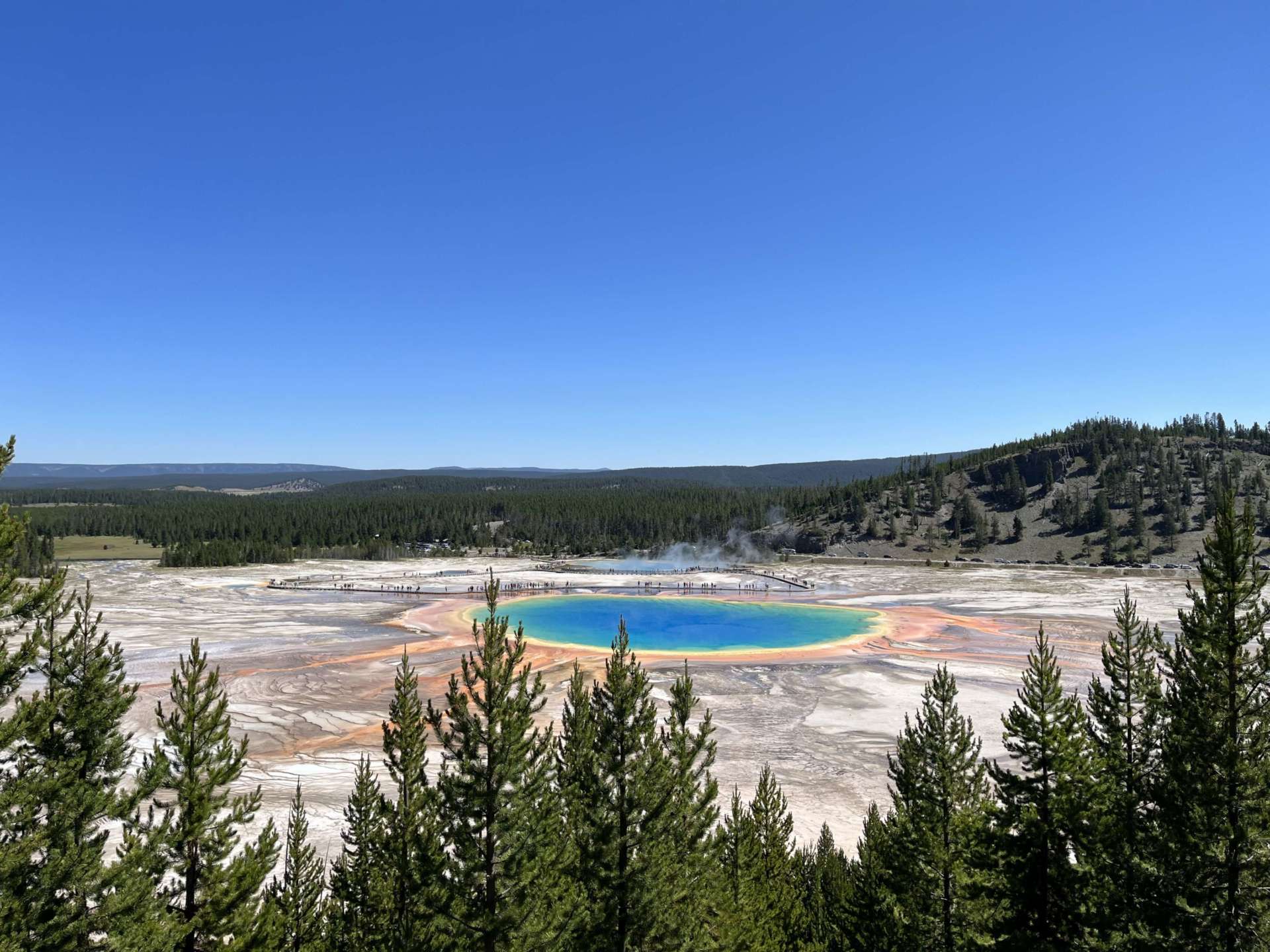
Day four began with an excursion to the Lamar Valley in the northeastern corner of the park. This is the area where wolves were famously reintroduced to Yellowstone in 1995. The recovery of aspen and willow stands, freed from elk over browsing, is a testament to the cascading ecological effects of wolf reintroduction in Yellowstone. We embarked on a “moderately strenuous” hike up Specimen Ridge, rewarded with a spectacular view of bison herds, pronghorn “antelope,” and impressive fossilized redwood trees. These fossilized specimens, dating back 50 million years, give the ridge its name. Near the ridge’s summit, we heard a pack of wolves howling and yipping in the distance. We scanned the landscape but could not spot the pack. It was a thrilling sensation to experience wolves as an auditory presence within the vast landscape.
The following day we relocated our camp to Bridge Bay near Yellowstone Lake and hiked the north rim of the Grand Canyon of the Yellowstone River. The scenery here is famously portrayed in the epic painting by Thomas Moran displayed in the United States Capitol Building. The nine-foot-wide painting was based on Moran’s sketches and watercolors, and William Henry Jackson’s photographs, collected during the 1871 expedition into the Yellowstone Plateau led by geologist Ferdinand Vandeveer Hayden. These visual works played a crucial role in convincing a skeptical public that the stories about Yellowstone were true and persuading Congress to designate it as a national park in 1872.
On day six, we woke before sunrise to catch the dawn in Hayden Valley. As the colors of dawn painted the sky, a thousand birds welcomed the day, and the valley’s morning mist receded to reveal pillars of hydrothermal steam, resembling smoke from hidden chimneys. Dawn in Yellowstone is like the birth of the world, and your heart yearns to stay in the moment. Nevertheless, we left Hayden Valley to revisit the canyon and Artist Point on the south rim before the crowds arrived. Yellowstone spans an enormous area, covering 63 miles north to south and 54 miles east to west. Nevertheless, the main attractions host throngs of visitors during the peak summer season and by mid-day, Artist Point would be jammed. However, with the sun just climbing above the mountains, we were the only ones there. Despite receiving over four million visitors annually, it does not require much effort to find solitude in Yellowstone. Just wake before dawn or linger until sunset or pick any trail and walk for five minutes.
In the afternoon, after a refreshing swim in Yellowstone Lake’s 52-degree waters, we ventured out along the east park entrance road, passing through land that burned in 2003. Charred lodgepole pine trunks covered the landscape, with many still standing. Free from the shade of the pines, the understory has been reborn as wildflower pastures teeming with animal and insect life. Young lodgepoles were regrowing, likely from seeds released from resin-bound cones opened by the wildfires’ heat. Fire ecology is an integral part of Yellowstone, and for the lodgepoles, fire is a crucial element of their life cycle. Grizzly bears are abundant in the regenerating forests, and we spotted one on our way to the Lake Butte Overlook hunting ground squirrels among decaying trees. The overlook provided a panoramic view of the lake 600 feet below, with peaks of the Teton Range visible about 60 miles to the southeast through the atmospheric haze of the late afternoon. In between lies the Thorofare, the most remote area in the 48 contiguous states.
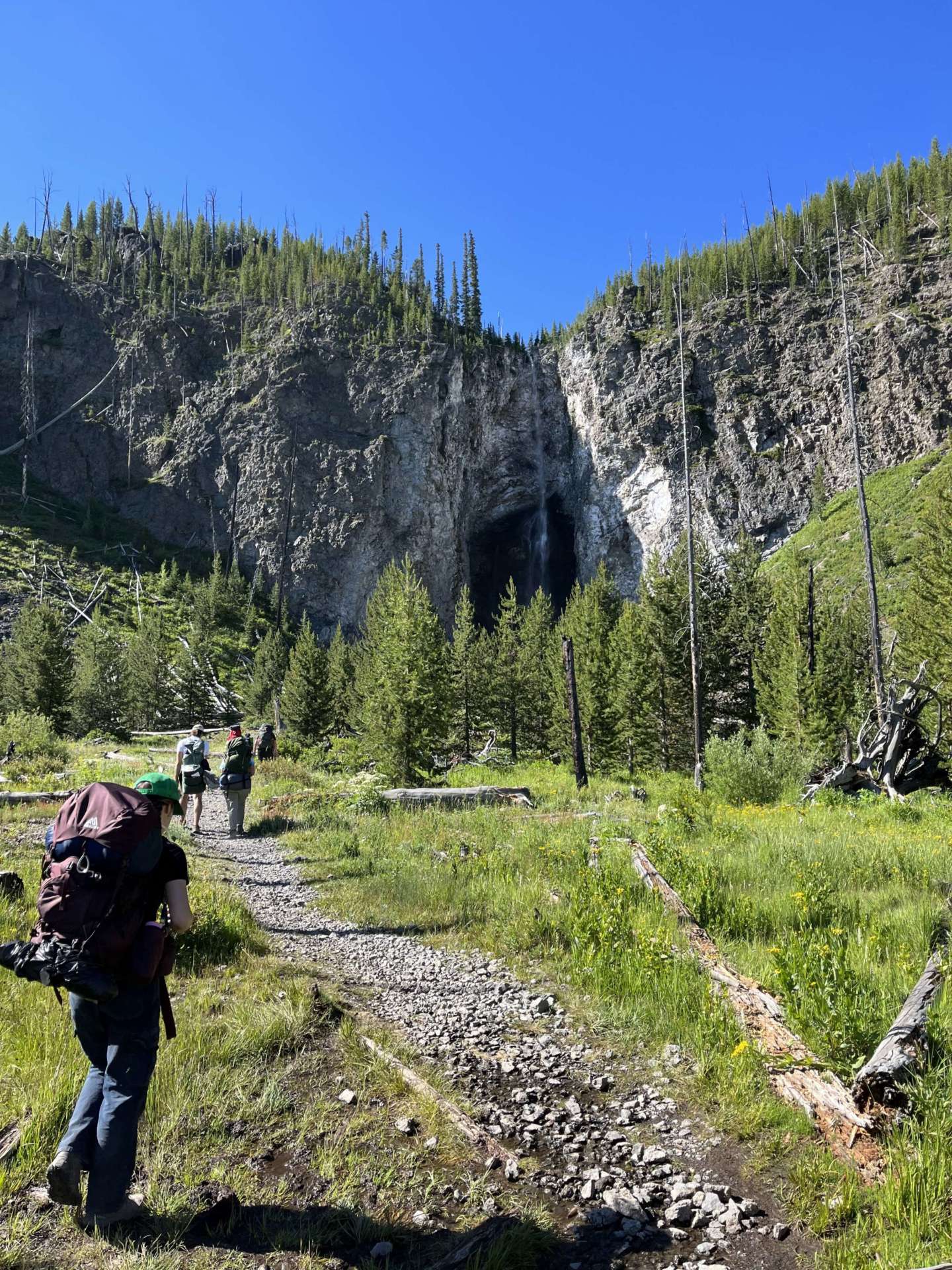 The following day would be our last full day in Yellowstone, and we aimed to spend it in the backcountry. After breaking camp, packing our backpacks, and watching an informational video about backcountry safety and etiquette at the ranger station, we set off for the Freight Road Trailhead, not far from where Thomas Brock made his microbial discovery. The gray sky hinted at showers, which began shortly after we started our hike. We paused to put on rain gear and continued to our destination in Imperial Meadows. A few hours later, the showers had subsided, replaced by blue skies and strong wind that made setting up camp a challenge. From our campsite, we could see the windswept gossamer veil of Fairy Falls to the southwest. The winds calmed by late afternoon, only to be replaced by biting flies. As the sun set, a bald eagle took a rest in a nearby tree, and we got some rest from the flies as they changed shifts with the mosquitos. Dowsed in insect repellent, we communed by the campfire, some of us lingering well after dark to gaze at the stars in the moonless sky, far removed from civilization.
The following day would be our last full day in Yellowstone, and we aimed to spend it in the backcountry. After breaking camp, packing our backpacks, and watching an informational video about backcountry safety and etiquette at the ranger station, we set off for the Freight Road Trailhead, not far from where Thomas Brock made his microbial discovery. The gray sky hinted at showers, which began shortly after we started our hike. We paused to put on rain gear and continued to our destination in Imperial Meadows. A few hours later, the showers had subsided, replaced by blue skies and strong wind that made setting up camp a challenge. From our campsite, we could see the windswept gossamer veil of Fairy Falls to the southwest. The winds calmed by late afternoon, only to be replaced by biting flies. As the sun set, a bald eagle took a rest in a nearby tree, and we got some rest from the flies as they changed shifts with the mosquitos. Dowsed in insect repellent, we communed by the campfire, some of us lingering well after dark to gaze at the stars in the moonless sky, far removed from civilization.
We awoke the next day to find a lone bison grazing on the outskirts of our camp. Our trail out of the backcountry took us past Fairy Falls and Grand Prismatic Spring. By late morning, the steam that often obscures Grand Prismatic had dissipated. Crowds of people gathered at the overlook, eager to snap selfies at the park’s most famous hot spring. Pushing through the crowds, I could not help but long for the solitude of the backcountry. We returned to our vehicles to begin a 65-mile drive out the south entrance of Yellowstone and on to Grand Teton National Park. Before long, all the passengers in my van were asleep, exhausted from the backcountry hike. To stay alert, I sipped an energy drink and thought of Truman Everts, the 54-year-old tax assessor from Montana who took part in an 1870 expedition into the Yellowstone Plateau. He became separated from the main group somewhere in the dense lodgepole forests we were now passing south of Yellowstone Lake. He lost his horse and most of his belongings, endured harassment from mountain lions, sustained severe burns from hydrothermal vents, accidentally started a forest fire, and suffered frostbite from October snows. Thirty-seven days later, delirious and severely malnourished, he was found by two local mountain men and returned to Bozeman to share his harrowing tale in Scribner’s Monthly.
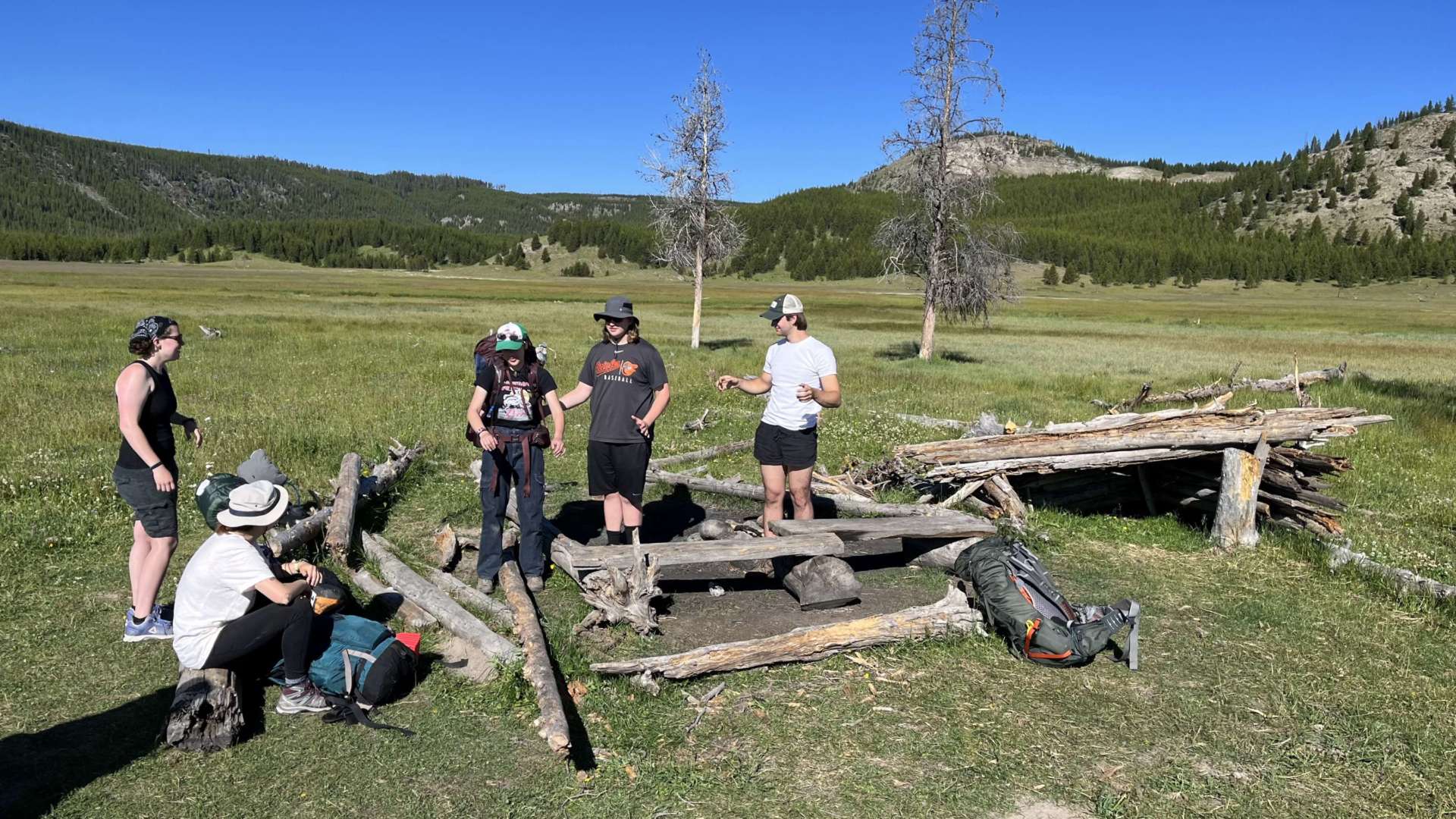
Our Yellowstone adventure had come to an end, but we still had two nights in Grand Teton National Park to ease our transition back to civilization. After Yellowstone, Grand Teton felt more civilized, offering creature comforts like cell service and daily showers. Our first stop, after checking in at Colter Bay Campground, was the pizzeria at Leek’s Marina on Jackson Lake. I can’t say whether Leek’s makes the best pizza in the world, but it certainly tastes that way after six days of camping in Yellowstone and a night in the backcountry. Following dinner, we headed to the Jackson Lake Lodge to witness the sunset behind the Teton Range.
The Tetons are among the youngest mountains in North America, with uplift beginning less than ten million years ago along a fault at the eastern edge of the mountains. However, the metamorphic granite forming the peaks, known as gneiss, is over two and a half billion years old. Near the summit of Mount Moran lies my favorite geological curiosity in these mountains: a vertical black seam of diabase, formed nearly a billion years ago when the rock was still deep below the surface and magma intruded into a fissure. The diabase and gneiss peak are capped by 500-million-year-old sandstone, deposited when the region was at the edge of an ancient sea.
The following day, we hiked around Jenny Lake at the base of the mountains, passing a black bear foraging in the dappled shade of a forest clearing. A moose and her calf grazed nearby. We found respite in the cool mist of Hidden Falls and marveled at the view from Inspiration Point. Forgoing the return hike, we took a water taxi across the lake and enjoyed an afternoon swim in String Lake.
On our last day, we began the journey back to Salt Lake City for our return trip home. Still, we aimed to squeeze more experiences into the day. We made stops at the visitor center in the town of Moose and the National Museum of Wildlife Art in Jackson. This museum’s collections include works by John James Audubon, Georgia O’Keeffe, and Andy Warhol, but my favorite works are by lesser-known artists such as Carl Rungius and Robert Kuhn. The sculpture garden features pieces from the Lost Bird Project, memorializing bird species that have gone extinct in modern times. Our final stop, after several hours on the highway through the ever-changing landscape of western Wyoming, was Fossil Butte National Monument. Arriving just half an hour before the visitor center closed, we were treated to fossilized remains of animals and plants dating back 50 million years, formed when Kemmerer, Wyoming was an ancient lakebed.
Epilogue
Months have passed since we left Yellowstone and Grand Teton, but I hope that Yellowstone and Grand Teton never leaves us. As our students resume their everyday lives, I hope the experience remains with them always. I hope it is a testament to the power of an integrative educational approach and the transformative impact of field experiences. Truly understanding the connections between the diverse subjects we explored requires immersing oneself in the dynamic landscapes of these iconic parks. I hope that this underscores the vital role of immersive field experiences in higher education, especially for environmental students. Bridging the divide between classroom instruction and the real world is not just something to value; it is something to which we need to be dedicated and is essential to nurture the passionate stewards our planet urgently needs.
Dr. Jeff Groff is a professor of physics in the Department of Natural and Physical Sciences. He teaches physics, environmental science, energy, geographic information systems, computers, electronics, and field courses at Yellowstone and Grand Teton National Parks. He earned Shepherd’s Outstanding Teaching Award in 2017 and was the 2019 Faculty Merit Foundation of West VirginiaWest Virginia Professor of the Year.
— 30 —
